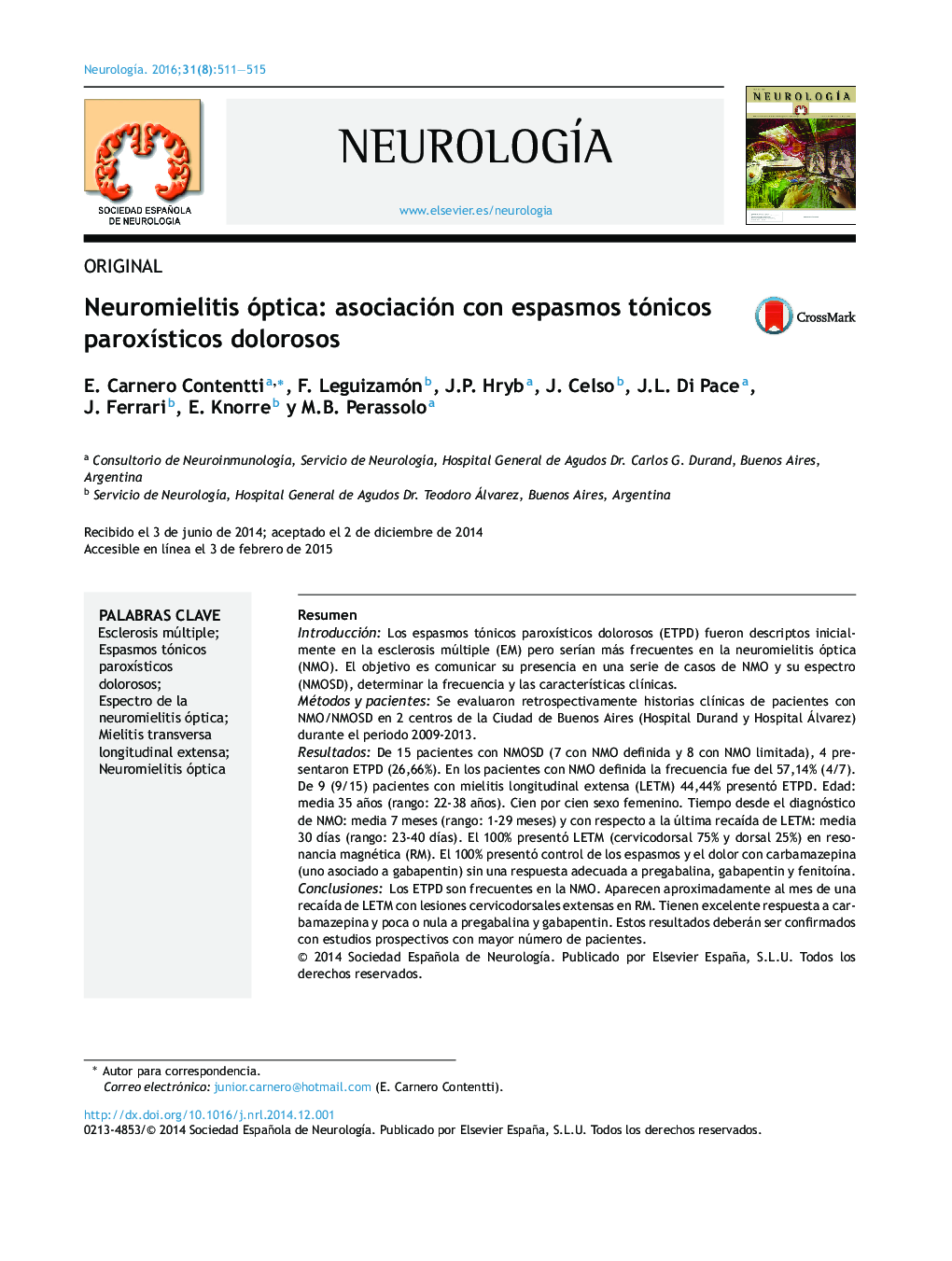| Article ID | Journal | Published Year | Pages | File Type |
|---|---|---|---|---|
| 5631725 | Neurología | 2016 | 5 Pages |
ResumenIntroducciónLos espasmos tónicos paroxÃsticos dolorosos (ETPD) fueron descriptos inicialmente en la esclerosis múltiple (EM) pero serÃan más frecuentes en la neuromielitis óptica (NMO). El objetivo es comunicar su presencia en una serie de casos de NMO y su espectro (NMOSD), determinar la frecuencia y las caracterÃsticas clÃnicas.Métodos y pacientesSe evaluaron retrospectivamente historias clÃnicas de pacientes con NMO/NMOSD en 2 centros de la Ciudad de Buenos Aires (Hospital Durand y Hospital Álvarez) durante el periodo 2009-2013.ResultadosDe 15 pacientes con NMOSD (7 con NMO definida y 8 con NMO limitada), 4 presentaron ETPD (26,66%). En los pacientes con NMO definida la frecuencia fue del 57,14% (4/7). De 9 (9/15) pacientes con mielitis longitudinal extensa (LETM) 44,44% presentó ETPD. Edad: media 35 años (rango: 22-38 años). Cien por cien sexo femenino. Tiempo desde el diagnóstico de NMO: media 7 meses (rango: 1-29 meses) y con respecto a la última recaÃda de LETM: media 30 dÃas (rango: 23-40 dÃas). El 100% presentó LETM (cervicodorsal 75% y dorsal 25%) en resonancia magnética (RM). El 100% presentó control de los espasmos y el dolor con carbamazepina (uno asociado a gabapentin) sin una respuesta adecuada a pregabalina, gabapentin y fenitoÃna.ConclusionesLos ETPD son frecuentes en la NMO. Aparecen aproximadamente al mes de una recaÃda de LETM con lesiones cervicodorsales extensas en RM. Tienen excelente respuesta a carbamazepina y poca o nula a pregabalina y gabapentin. Estos resultados deberán ser confirmados con estudios prospectivos con mayor número de pacientes.
IntroductionParoxysmal painful tonic spasms (PPTS) were initially described in multiple sclerosis (MS) but they are more frequent in neuromyelitis optica (NMO). The objective is to report their presence in a series of cases of NMO and NMO spectrum disorders (NMOSD), as well as to determine their frequency and clinical features.Patients and MethodsWe conducted a retrospective assessment of medical histories of NMO/NMOSD patients treated in 2 hospitals in Buenos Aires (Hospital Durand and Hospital Álvarez) between 2009 and 2013.ResultsOut of 15 patients with NMOSD (7 with definite NMO and 8 with limited NMO), 4 presented PPTS (26.66%). PPTS frequency in the definite NMO group was 57.14% (4/7). Of the 9 patients with longitudinally extensive transverse myelitis (LETM), 44.44% (9/15) presented PPTS. Mean age was 35 years (range, 22-38 years) and all patients were women. Mean time between NMO diagnosis and PPTS onset was 7 months (range, 1-29 months) and mean time from last relapse of LETM was 30 days (range 23-40 days). LETM (75% cervicothoracic and 25% thoracic) was observed by magnetic resonance imaging (MRI) in all patients. Control over spasms and pain was achieved in all patients with carbamazepine (associated with gabapentin in one case). No favourable responses to pregabalin, gabapentin, or phenytoin were reported.ConclusionsPPTS are frequent in NMO. Mean time of PPTS onset is approximately one month after an LETM relapse, with extensive cervicothoracic lesions appearing on the MRI scan. They show an excellent response to carbamazepine but little or no response to pregabalin and gabapentin. Prospective studies with larger numbers of patients are necessary in order to confirm these results.
